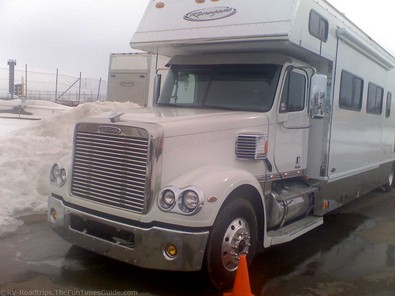 Well, it looks like we’re going to be driving an RV for the first time in the winter snow.
Well, it looks like we’re going to be driving an RV for the first time in the winter snow.
I have to admit, I’m a little nervous about it.
I mean it’s hard enough keeping a regular car on the road… let alone a long & skinny motorhome!
Here are some winter RV driving tips that we found helpful…
[Hint: Be sure to click to read more great tips from each ‘source’.]
Motorhomes are rear wheel drive, so all those new generation driving techniques go right out the window. It’s back to steering into the slide and pumping the brakes lightly in order to attempt to regain control. Applying power may actually make matters worse. Unlike front wheel drive vehicles, where adding power may allow you to steer out of a slide, adding power to a rear wheel drive vehicle may compound the skid. Source
Make sure you have enough propane. This can be a real problem, especially in a motorhome. Waking up and finding your heat is out, can also be dangerous to some of us who have health problems. Again, if you are staying in the park long term, see if you can utilize, rent or purchase one of the 50 or 100 gallon propane tanks to connect to your RV. This allows for longer times between fill ups in a cold spell. If the park allows it, run small electric or catalytic space heaters. This allows you to conserve propane. Don’t try to add heat to the RV by running the stove and/or cooktop. Just like in the north, if your heater isn’t doing it’s job, have it checked out. Carbon monoxide will kill in an RV too! Source
Part of the plumbing system includes the holding tanks. Some RVs have enclosed holding tanks that are heated by the RV’s furnace through heater ducting to the holding tank areas. As long as the furnace runs occasionally, the tanks won’t freeze unless it’s very cold (below 20F). For those tanks that are not heated and/or enclosed, tank heating pads can be affixed to the bottoms of the tanks. These are very easy to install, thermostatically-controlled, and come in both 12-volt DC and 110-volt AC. Source
You should have more than just your RV furnace for your source of heat. You’ll find yourself going through a lot of propane if you rely on forced air heat alone. Protecting your water and sewer lines are also a must if you plan on using your kitchen and bathroom. Anything you can do to reduce drafts and add extra insulation will go a long way in keeping you comfortable. Using electric blankets can help keep you cozy and warm too. Source
You are probably going to encounter some areas that require the use of tire chains. If it becomes necessary to chain up, park the coach in a safe location. Place warning cones 10 feet behind the coach, and have someone in your group keep an eye out for oncoming traffic. You may luck out at a mountain pass and discover that others will put on the tire chains for a fee. Take advantage of the service and pay them to do it. Regardless of who installs the tire chains, make a point to re-inspect the work before taking off down the road. When you are driving with chains, keep the speed down and stop occasionally for a walk-around inspection. Source
For winterizing the sewer line, instead of using the standard slinky style hose that you can buy at the RV dealer, we went to the home center and bought hard line PVC tube and built a more substantial setup. By installing it with a modest slope, we were assured it would drain quickly — so it didn’t need any further insulation. Source





